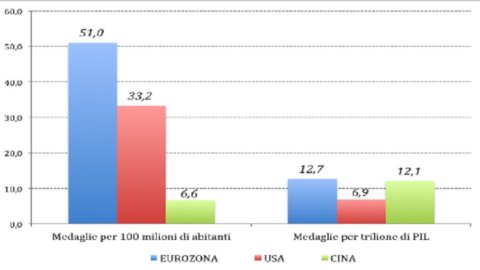Now that the spotlights on the London Olympics have gone out, some considerations can be made on the overall results. While the Eurozone gives itself a dodgy image these days, it's interesting compare the results obtained by the total of the 17 countries that have chosen to link up with a single currency. It is an area comparable with the two main dominators of these Olympics: the USA and Cin.
With 104 medals for the USA (46 gold), and 88 for China (38 gold), these are the two powers with the most medals. Russia, with its 82 medals (only 24 gold medals), was far behind, being overtaken in terms of gold medals also by Great Britain (29, out of a total of 65 medals), which also, as our Cammarelle and many other non-British athletes would have had some help.
The numbers tell us that the Eurozone gathers 330 million inhabitants, completely comparable with the USA (314 million) even if less than a quarter of the 1.342 million inhabitants boasted by China. In terms of GDP, at market values not adjusted for purchasing power parity, the Eurozone stands at about 13 trillion dollars, against 15 for the USA and 7 for China. So these are three fairly comparable areas.
And the comparison confirms that the Eurozone as a whole it doesn't disfigure at all. On the contrary, with 168 medals overall, it outclasses both the US and China, although just 41 of those medals are of the most precious metal. Thus, in terms of gold, the Eurozone bows to the US and only narrowly outpaces China. But comparisons, to be more precise, as we know, must be made by relating to something.
If we calculate the number of medals per 100 million inhabitants, the Eurozone is stratospheric, reaching the number of 51,0, much higher than the 33,2 of the USA and even more than the 6,6 of China. And the number of medals per trillion dollars of GDP is also very comforting: 12,7 for the Eurozone, against 12,1 for China and just 6,9 for the USA (see graph).
This image of strength of the Eurozone weakens a bit if, instead of looking at the total number of medals won, we focus on the gold medals alone. In this case, the Eurozone ranks below the US, although well above China if we relate to the population (respectively 12,4 gold medals per 100 million inhabitants for the Eurozone, 14,7 for the USA and 2,8 for China) and, while marginally surpassing the USA, far below China in terms of GDP (3,1, 3,0 and 5,2 gold medals per trillion of GDP respectively) .
Another aspect already noted for the Eurozone is the low proportion of gold medals in relation to the total medals, a sort of "syndrome of the second" (or of the third). In fact, the percentage is 27,0 for the Eurozone, against 43,2 for China and 44,2 for the USA. Among the three positions available on the podium, the Eurozone seems to have a marked propensity for silver (37,8 per cent, against 30,7 for China and 27,9 for the USA) and, albeit slightly less , to bronze (35,1 percent against 27,9 for the USA and 26,1 for China).
But how have the various members of the Eurozone behaved? Partially different indications are obtained depending on whether we look at the total number of medals per 100 million inhabitants or per trillion of GDP. Let's consider only the five largest countries: France, Germany, Italy, Holland and Spain. It is there'Holland to be astronomical with its 119,8 medals per 100 million inhabitants. Among others, there is a certain supremacy of Germany (54,1) over France (51,8) and even more over Italy (45,8), but the most detached is Spain (only 36,2).
However, if we compare the five countries by comparing medals to GDP, the picture that emerges is different. Apart from the excellence of Holland, which is confirmed with 23,8 medals per trillion of GDP, Germany and France are substantially on par (12,3 and 12,2), Italy is slightly better (12,7) and even Spain (11,4), although still last, is not that far away (Fig. 5).
And what can be said of the five countries in terms of “second syndrome” (or third)? Figure 6 shows the percentages of gold, silver and bronze medals out of the total for each of the countries considered. Indeed, there are interesting indications. While the percentage of golds is close to 1/3 for France (32,4) and the Netherlands (30,0) and only slightly lower for Italy (28,6), it stands at 25,0 for Germany and even 17,6 for Spain.
In conclusion, the Eurozone is also an exceptional reality in sport. The only flaw, if you want to find one, is what we have called "syndrome of the second". Of course, we are well aware that this syndrome depends on many factors. However, given that there was a need for the "fiscal compact", the "growth compact" and the "banking compact", it is not that we also need a "sport compact"





